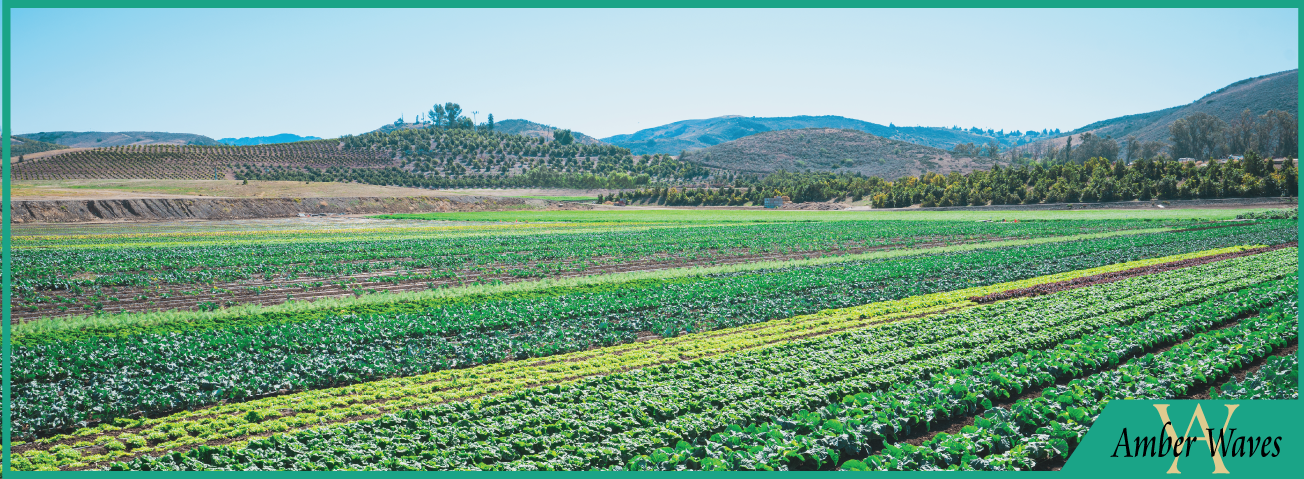
USDA Created Organic Assistance Programs From 2021–23 in Response to Disruptions, Decreased Organic Transitioning Acreage
- by Sharon Raszap Skorbiansky and Katherine L. Baldwin
- 3/25/2024
U.S. agriculture has been affected by unexpected events over the past few years, including the Coronavirus (COVID-19) pandemic, drought, the war in Ukraine, and high inflation. Organic commodity producers were further affected by lost markets, labor shortages, and difficulty obtaining or renewing their organic certification. In 2021, the USDA, National Agricultural Statistics Service recorded an 11-percent decrease in certified organic land and an 18-percent decrease in land transitioning to organic compared with 2019. Additionally, the number of producers who reported they would be decreasing or discontinuing organic production increased to 8 percent from 6 percent during that time.
USDA responded by launching several one-time investment programs to help farmers with unique uncertainties and to reduce barriers to transitioning to organic. These programs included cost assistance, grants, and technical assistance and education. Most were carried out under the umbrella of the Organic Transition Initiative, a multiagency $300 million investment to help transitioning organic producers. Although organic producers are eligible for all USDA programs and assistance, they use different production practices and face different markets, so programs tailored to organic producers can better address their needs. Other organic assistance programs offered by USDA include the National Organic Certification Cost-Share Program and the Environmental Quality Incentives Program (EQIP) Organic Initiative.
Cost-Share Assistance Programs
The USDA, Farm Service Agency’s (FSA) Organic and Transitional Education and Certification Program (OTECP) was part of the Pandemic Assistance for Producers Initiative. The economic challenges associated with the pandemic made it difficult for many farmers to obtain or renew USDA organic certification. Through OTECP, $20 million was made available for producer assistance. Under this program, producers received reimbursement for qualifying expenses they paid between October 2019 and September 2022. For transitional operations, the program covered a share of fees farmers paid for precertification inspections and the development of an organic system plan. Certified operations received assistance for fees associated with applications, inspections, trade equivalency agreements, and testing soil for micronutrient deficiencies. Producers also received cost reimbursement for education events.
FSA’s Organic Dairy Marketing Assistance Program (ODMAP) made $104 million available in 2023 in response to economic challenges faced in recent years by small organic dairy operations. For instance, domestically grown feed markets have been thin, exacerbated by drought in major forage-producing regions as well as Russia’s invasion of Ukraine, which disrupted organic feed supply originating from Ukraine. Organic dairy farmers continue to face transportation and trade challenges in the pandemic’s aftermath. Signup rates for ODMAP were low, so FSA did not spend all available funds for the program.
The USDA, Risk Management Agency (RMA) Transitional and Organic Grower Assistance (TOGA) program—operated under the Organic Transition Initiative—provided Federal crop insurance premium assistance to certified and transitional organic producers for the 2023 reinsurance year (July 1, 2022, to June 30, 2023). To help farmers afford the transition into organic production, the program provided 10 percentage points of premium subsidy for crops in transition. The TOGA program also provided a premium subsidy of $5 per insured acre to producers of organic grain and feed crops to help boost the production of organic U.S. feed crops, a market that has struggled to meet demand.
Grant Programs
The USDA, Agricultural Marketing Service (AMS) Organic Market Development Grant (OMDG)—another program of the Organic Transition Initiative—provided $75 million in funding for projects that expand capacity for production, processing, storage, transportation, wholesaling, and distribution of organic products. The fiscal year 2023 program focused on building and expanding in areas of critical need in the organic supply chain, including organic grains and livestock feed, organic fibers, and other organic ingredients currently unavailable domestically.
Technical Assistance and Education Programs
Another AMS Organic Transition Initiative program, the Transition to Organic Partnership Program (TOPP), invests $100 million over 5 years in cooperative agreements between USDA and nonprofit partner organizations to provide training and education to transitioning and recently transitioned organic farmers. Partner organizations will connect farmers with mentors, build mentoring networks, provide community-building opportunities such as workshops and field days, and engage with educational and training institutions or organic workforce training.
The USDA, Natural Resources Conservation Service (NRCS) has two Organic Transition Initiative investments. First, NRCS is investing $5 million in hiring organic experts through 5-year agreements to provide hands-on training and assist field staff with organic-related questions. Second, NRCS is investing $70 million to help and educate producers (including field days with NRCS staff or technical service providers) on the new organic management standard under EQIP. Through this program, NRCS will help producers with conservation activities and practices required for organic certification. For example, the National Organic Standards support composting, outdoor access for livestock, and organic nutrient management, all covered under the new standard.
This article is drawn from:
- Baldwin, K.L., Williams, B., Tsiboe, F., Effland, A., Turner, D., Pratt, B., Jones, J.W., Toossi, S. & Hodges, L. (2023). U.S. Agricultural Policy Review, 2021. U.S. Department of Agriculture, Economic Research Service. EIB-254.
- Baldwin, K.L., Williams, B., Sichko, C., Tsiboe, F., Toossi, S., Jones, J.W., Turner, D. & Raszap Skorbiansky, S. (2023). U.S. Agricultural Policy Review, 2022. U.S. Department of Agriculture, Economic Research Service. EIB-260.
- Knight, R., Taylor, H., Hahn, W., Terán, A., Haley, M., Grossen, G. & Valcu-Lisman, A. (2023). Livestock, Dairy, and Poultry Outlook: February 2023. U.S. Department of Agriculture, Economic Research Service. LDP-M-344.
You may also like:
- Raszap Skorbiansky, S., Carlson, A. & Spalding, A. (2023, November 14). Rising Consumer Demand Reshapes Landscape for U.S. Organic Farmers. Amber Waves, U.S. Department of Agriculture, Economic Research Service.
- Organic Agriculture. (n.d.). U.S. Department of Agriculture, Economic Research Service.
- Carlson, A., Greene, C., Raszap Skorbiansky, S., Hitaj, C., Ha, K.A., Cavigelli, M., Ferrier, P. & McBride, W.D. (2023). U.S. Organic Production, Markets, Consumers, and Policy, 2000–21. U.S. Department of Agriculture, Economic Research Service. ERR-315.


